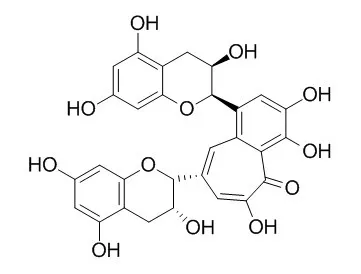| Description: |
Theaflavin is a suitable natural inhibitor against influenza A (H1N1) neuraminidase, which has anti-inflammatory, antioxidative, anti-mutagenic, anti-HSV-1, and anti-carcinogenic properties. Theaflavin is active in the prevention of fatty liver and obesity, it can significantly reduce lipid accumulation, suppress fatty acid synthesis, and stimulate fatty acid oxidation. Theaflavin inhibits LPS-Induced IL-6, MCP-1, and ICAM-1 expression in bone marrow-derived macrophages through the blockade of NF-κB and MAPK signaling pathways; it also protects nigral dopaminergic neurons against chronic MPTP/probenecid induced Parkinson's disease. |
| Targets: |
Antifection | ROS | TNF-α | NF-kB | IL Receptor | IkB | ERK | JNK | p38MAPK | Caspase | AMPK | IKK | H1N1 | HSV-1 | MCP-1 | ICAM-1 | FAS |
| In vitro: |
| J Microbiol Biotechnol. 2013 Sep 28;23(9):1322-6. | | Antifungal synergy of theaflavin and epicatechin combinations against Candida albicans.[Pubmed: 23711519] | New antifungal agents are required to compensate for the increase in resistance to standard antifungal agents of Candida albicans, which is an important opportunistic fungal pathogen that causes minor infections in many individuals but very serious infections in those who are immune-compromised.
METHODS AND RESULTS:
In this study, combinations of Theaflavin and epicatechin are investigated as potential antifungal agents and also to establish whether antifungal synergy exists between these two readily accessible and cost-effective polyphenols isolated from black and green tea. The results of disc diffusion assays showed stronger antibacterial activity of Theaflavin:epicatechin combinations against C. albicans NCTC 3255 and NCTC 3179, than that of Theaflavin alone. Minimum inhibitory concentrations (MICs) of 1,024 μg/ml with Theaflavin and 128-256 μg/ml with Theaflavin:epicatechin combinations were found. The fractional inhibitory concentration indexes were calculated, and the synergy between Theaflavin and epicatechin against both isolates of C. albicans was confirmed.
CONCLUSIONS:
Theaflavin:epicatechin combinations show real potential for future use as a treatment for infections caused by C. albicans. | | Genomics Inform . 2016 Sep;14(3):96-103. | | Identification of Suitable Natural Inhibitor against Influenza A (H1N1) Neuraminidase Protein by Molecular Docking[Pubmed: 27729839] | | Abstract
The influenza A (H1N1) virus, also known as swine flu is a leading cause of morbidity and mortality since 2009. There is a need to explore novel anti-viral drugs for overcoming the epidemics. Traditionally, different plant extracts of garlic, ginger, kalmegh, ajwain, green tea, turmeric, menthe, tulsi, etc. have been used as hopeful source of prevention and treatment of human influenza. The H1N1 virus contains an important glycoprotein, known as neuraminidase (NA) that is mainly responsible for initiation of viral infection and is essential for the life cycle of H1N1. It is responsible for sialic acid cleavage from glycans of the infected cell. We employed amino acid sequence of H1N1 NA to predict the tertiary structure using Phyre2 server and validated using ProCheck, ProSA, ProQ, and ERRAT server. Further, the modelled structure was docked with thirteen natural compounds of plant origin using AutoDock4.2. Most of the natural compounds showed effective inhibitory activity against H1N1 NA in binding condition. This study also highlights interaction of these natural inhibitors with amino residues of NA protein. Furthermore, among 13 natural compounds, Theaflavin, found in green tea, was observed to inhibit H1N1 NA proteins strongly supported by lowest docking energy. Hence, it may be of interest to consider Theaflavin for further in vitro and in vivo evaluation.
Keywords: influenza A Virus; molecular docking analysis; neuraminidase; phytochemicals. |
|
| In vivo: |
| Biochem Biophys Res Commun. 2012 Jan 6;417(1):287-93. | | Theaflavin attenuates ischemia-reperfusion injury in a mouse fatty liver model.[Pubmed: 22155236] | The incidence of non-alcoholic fatty liver disease (NAFLD) has been increasing, and there is a shortage of liver donors, which has led to the acceptance of steatotic livers for transplantation. However, steatotic livers are known to experience more severe acute ischemia-reperfusion (I/R) injury than normal livers upon transplantation. In the present study, we investigated the role of Theaflavin, a polyphenol substance extracted from black tea, in attenuating acute I/R injury in a fatty liver model.
METHODS AND RESULTS:
We induced I/R in normal and steatotic livers treated with or without Theaflavin. We also separated primary hepatocytes from the normal and steatotic livers, and applied RAW264.7 cells, a mouse macrophage cell line, that was pretreated with Theaflavin. We observed that liver steatosis, oxidative stress, inflammation and hepatocyte apoptosis were increased in the steatotic liver compared to the normal liver, however, these changes were significantly decreased by Theaflavin treatment. In addition, Theaflavin significantly diminished the ROS production of steatotic hepatocytes and TNF-α production by LPS-stimulated RAW264.7 cells.
CONCLUSIONS:
We concluded that Theaflavin has protective effects against I/R injury in fatty livers by anti-oxidant, anti-inflammatory, and anti-apoptotic mechanisms. | | J Lipid Res. 2007 Nov;48(11):2334-43. | | Theaflavins attenuate hepatic lipid accumulation through activating AMPK in human HepG2 cells.[Pubmed: 17720960 ] | Black tea is one of the world's most popular beverages, and its health-promoting effects have been intensively investigated. The antiobesity and hypolipidemic effects of black tea have attracted increasing interest, but the mechanisms underlying these phenomena remain unclear.
METHODS AND RESULTS:
In the present study, the black tea major component Theaflavins were assessed for their hepatic lipid-lowering potential when administered in fatty acid overload conditions both in cell culture and in an animal experimental model.
We found that Theaflavins significantly reduced lipid accumulation, suppressed fatty acid synthesis, and stimulated fatty acid oxidation. Furthermore, Theaflavins also inhibited acetyl-coenzyme A carboxylase activities by stimulating AMP-activated protein kinase (AMPK) through the LKB1 and reactive oxygen species pathways. These observations support the idea that AMPK is a critical component of decreased hepatic lipid accumulation by Theaflavin treatments.
CONCLUSIONS:
Our results show that Theaflavins are bioavailable both in vitro and in vivo and may be active in the prevention of fatty liver and obesity. |
|






 Cell. 2018 Jan 11;172(1-2):249-261.e12. doi: 10.1016/j.cell.2017.12.019.IF=36.216(2019)
Cell. 2018 Jan 11;172(1-2):249-261.e12. doi: 10.1016/j.cell.2017.12.019.IF=36.216(2019) Cell Metab. 2020 Mar 3;31(3):534-548.e5. doi: 10.1016/j.cmet.2020.01.002.IF=22.415(2019)
Cell Metab. 2020 Mar 3;31(3):534-548.e5. doi: 10.1016/j.cmet.2020.01.002.IF=22.415(2019) Mol Cell. 2017 Nov 16;68(4):673-685.e6. doi: 10.1016/j.molcel.2017.10.022.IF=14.548(2019)
Mol Cell. 2017 Nov 16;68(4):673-685.e6. doi: 10.1016/j.molcel.2017.10.022.IF=14.548(2019)